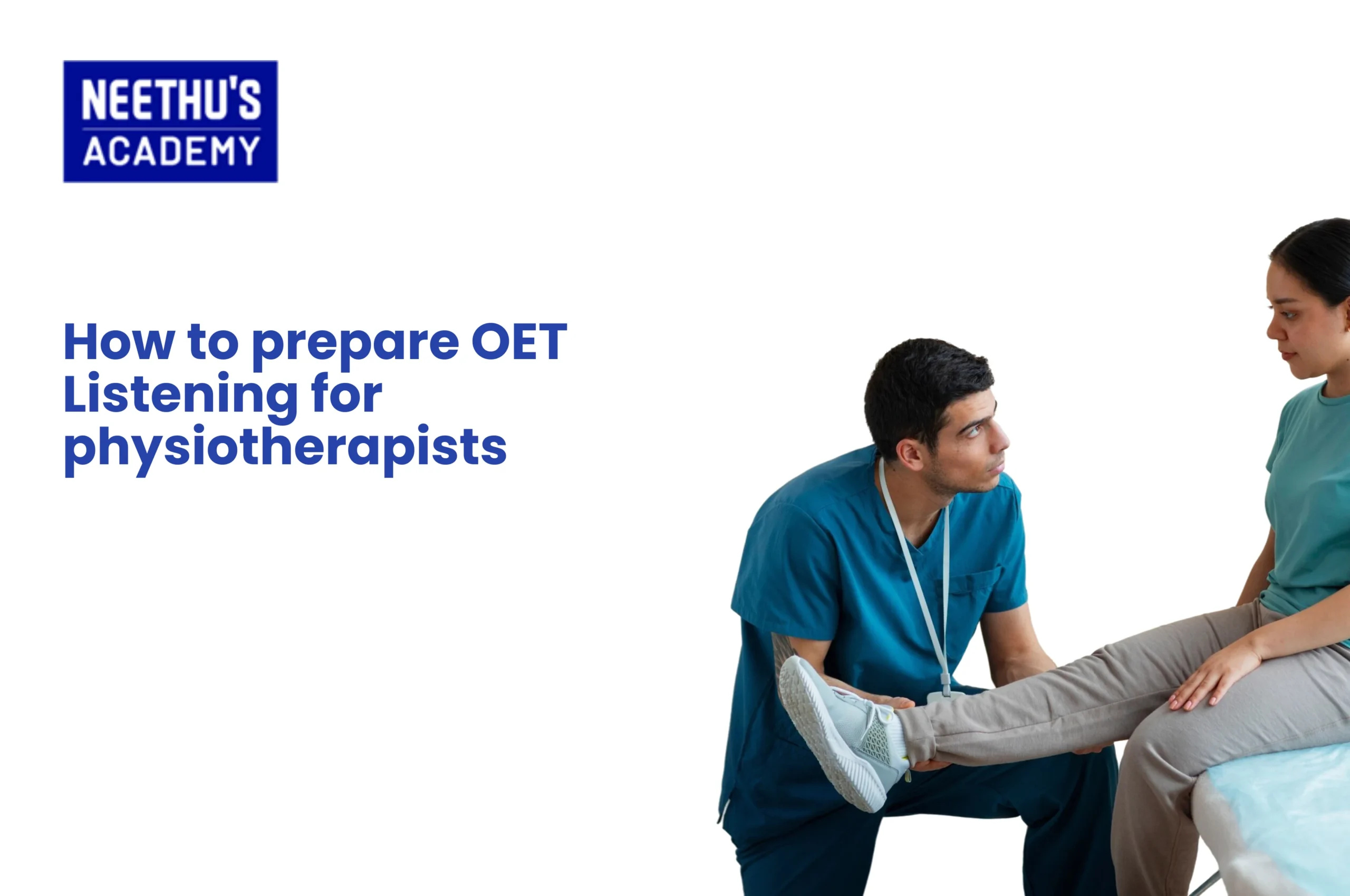The Occupational English Test, otherwise known as OET, is a professional test on language proficiency for healthcare professionals. Becoming great at reading…

How to Prepare OET Listening for Physiotherapists: A Complete Guide
For physiotherapists who wish to practice in English-speaking countries, passing the Occupational English Test (OET) is a fundamental step. While the listening subtest seems easy, without a tactical approach, numerous candidates find themselves unable to gain the desired grade. The OET Listening test for physiotherapists evaluates your ability to understand real clinical conversations and communicate efficiently in healthcare settings. This blog provides an overview of OET physiotherapist listening preparation, practical tips, and effective strategies to improve your listening skills and succeed in the exam.
Whether you’re self-preparing or enrolling in an OET coaching centre, this blog will take you through all you need to know.
Understanding the OET Listening Sub-test
The OET Listening sub-test is uniform for all healthcare professions, including physiotherapists. It takes approximately 40 minutes and consists of three parts:
Part A: Consultation Extracts
Two conversations between a patient and a healthcare professional. You will need to make notes as you listen.
Part B: Short Workplace Extracts
Six short recordings (around one minute), like briefings or conversations with work colleagues. Each has one multiple-choice question.
Part C: Presentation Extracts
Two extended audio recordings (5–6 minutes) on health matters, like lectures or interviews. You’ll respond to six multiple-choice questions per recording.
Every section tests various OET listening skills such as specific information, gist, inference, tone, and speaker attitude—skills that are important for physiotherapists who communicate with patients and other healthcare professionals.
Common challenges for Physiotherapists
Although experienced in clinical discussions, most physiotherapists struggle with specific challenges in the listening sub-test such as:
Information Overload in Part A:
Physiotherapists find it hard to keep pace with note-taking during hectic consultations. Important information is likely to be missed if you’re not good at active listening techniques.
Unfamiliar Terms in Part B & C:
General medical terminology is not an issue, but administrative or cross-professional jargon may look strange or unfamiliar to physiotherapists.
Varied Accents:
OET audios may include Australian, British, or other international English accents. If you’ve primarily learned American or Indian English, this can be disorienting at first.
Distractions and Irrelevant Details:
Sometimes the audio includes distractors—information that sounds important but isn’t the correct answer. Staying focused on the actual task is key.
Recognizing these issues early allows for more targeted OET physiotherapist listening practice and improved performance.
Effective Preparation Strategies
To prepare for better OET listening and come to the test with confidence, follow these powerful preparation techniques:
1. Practice Active Listening Daily
Listen to English audio daily—particularly health-related material. Select sources such as BBC Health, TED Talks, or The Health Report (ABC Australia). Practice summarizing key points verbally or recording them.
2. Learn the OET Listening Format
Use sample papers to familiarize yourself with how questions are structured. This helps train your brain to anticipate the type of response required and avoid wasting time during the exam.
3. Sharpen Your Note-Taking Skills
Especially in Part A, accurate and fast note-taking can be the difference between a B and a C grade. Use symbols, shorthand, or abbreviations you’re comfortable with. Practice writing down keywords rather than full sentences.
4. Master Vocabulary by Category
Split your vocabulary acquisition into clinical vocabulary (rehabilitation, range of motion), administrative vocabulary (referral, discharge), and popular idioms applied to healthcare discourse. This creates context for understanding.
5. Mark Keywords in Questions
During your reading time, highlight keywords in the questions. This will help you focus as you listen and recognise answers when they show up in the audio.
6. Practice Under Exam Conditions
Practice full listening tests under timed conditions without distractions. Review your errors to see patterns—do you miss questions because of speed, vocabulary, or focus?
These steps provide a systematic method to improve your OET physiotherapist audio preparation.
Professional Advice for Physiotherapists
As a physiotherapist, your discussions often involve patient histories, treatment planning, and follow-up appointments. These are also discussed in the OET audio. Here’s how to make use of that:
Utilize Profession-Specific Practice Material:
Listen to physiotherapy-specific consultation, rehabilitation interviews, or exercise therapy sessions. This makes the content more relatable and improves retention.
Practice Predictive Listening:
In consultations, physiotherapists frequently anticipate patient responses or outcomes. Practice anticipating what is likely to happen next in the consultation.
Notice Tone and Emotions:
Notice patient emotions like frustration, anxiety, or confusion. These tend to be indicators of how the flow of information will be and are practiced in Parts A and C.
Practice with Real-Life Transcripts:
Listen to audio recordings first and then read their transcripts. This helps you in understanding the type of answer and how information tends to be structured.
These suggestions make your listening preparation more accurate and minimise the chances of misinterpreting the audio.
Recommended Resources
Developing OET listening skills demands good-quality material. The following are some reliable resources for OET physiotherapist listening practice:
Online Tools:
OET Official Practice Portal – Provides profession-specific sample tests.
YouTube Channels such as E2Language, SLC OET, and OET Preparation Tips.
Podcasts: BBC Health Check, HealthLink Podcast, ABC’s The Health Report.
Mobile Apps:
OET Practice App
BBC Learning English
Listenwise
Books:
Official OET Preparation Book for Listening
Target 30 Listening Tests
Cambridge OET Practice Papers
Regular use of these tools will assist you in enhancing OET listening and your familiarity with the test scenario.
Best OET Coaching Centre in Kerala
If self-study is not yielding the expected results, taking admission in a reliable OET coaching center such as Neethu’s Academy can provide you with the discipline, motivation, and constructive criticism you need.
Why Enroll with Us?
- Trained Professionals: Our OET trainers are healthcare professionals.
- Specific Content for Physiotherapists: Exclusive focus on physiotherapy-specific listening skills.
- Mock Tests with Feedback: Customized feedback on areas of improvement.
- Reasonable and Flexible Schedules: Offline and online both are available.
- Community Learning: Interact with other candidates for group study and motivation.
We specialize in providing customized assistance for all OET professions. Our listening modules are realistic, structured, and based on the latest OET norms, which is why they are a popular choice among many physiotherapists.
Conclusion
OET Listening for physiotherapists is about establishing positive understanding, quick thinking, and direct note-taking. The exam mimics real clinical discussions, so the more you are comfortable with these conversations, the higher you will perform.
With regular OET physiotherapist listening practice, guided resources, and perhaps the aid of an experienced OET coaching centre, you can obtain confidence and accuracy, which will allow you to reach a B grade or better. Start early, practice consistently, and track your progress. With dedication and smart strategies, you’ll be ready to take on the OET Listening test and succeed.
Frequently Asked Questions
Practice daily with healthcare podcasts, simulate tests, and practice active listening skills.
It is an English language test of the communication abilities of overseas physiotherapists seeking registration.
Ensure equal accuracy in all three parts by practicing frequently and dominating clinical listening scenarios.
Establish good note-taking skills, identify the patient’s primary problems, and anticipate information flow during consultation.
Related Blogs
- All Posts
- OET
Course Enquiry
Latest Posts
- All Posts
- canada
- CBT
- DHA
- French
- GENERAL
- German
- Haad
- IELTS
- IQN NEW ZEALAND
- MOH
- NCLEX-RN
- NHRA
- OET
- OSCE
- Pearson Vue
- PROMETRIC
- PTE
- TOEFL
- Back
- NCLEX - NGN
- Back
- OET FOR PHYSIOTHERAPIST
- OET FOR PHARMACIST
- OET FOR DOCTORS



